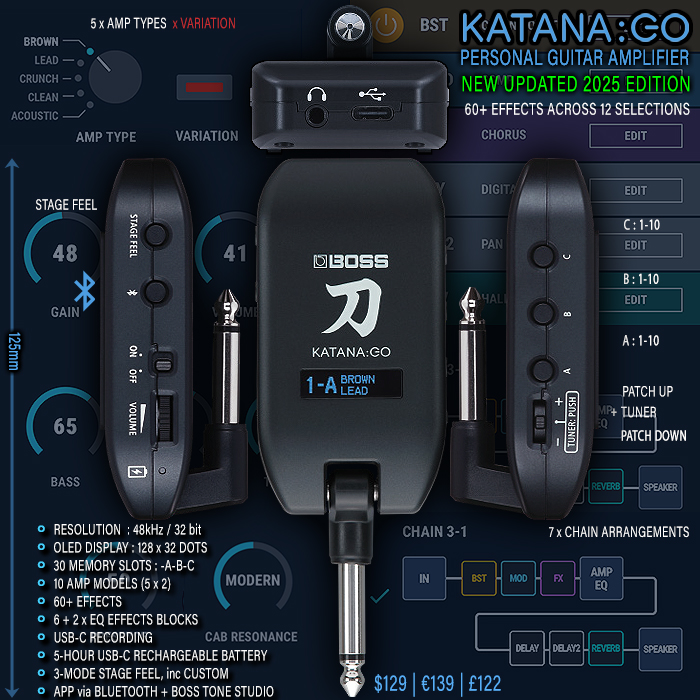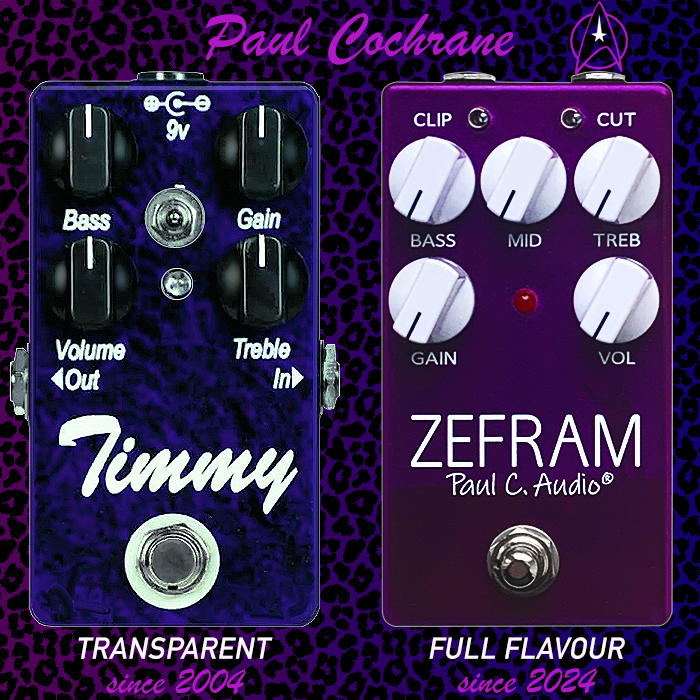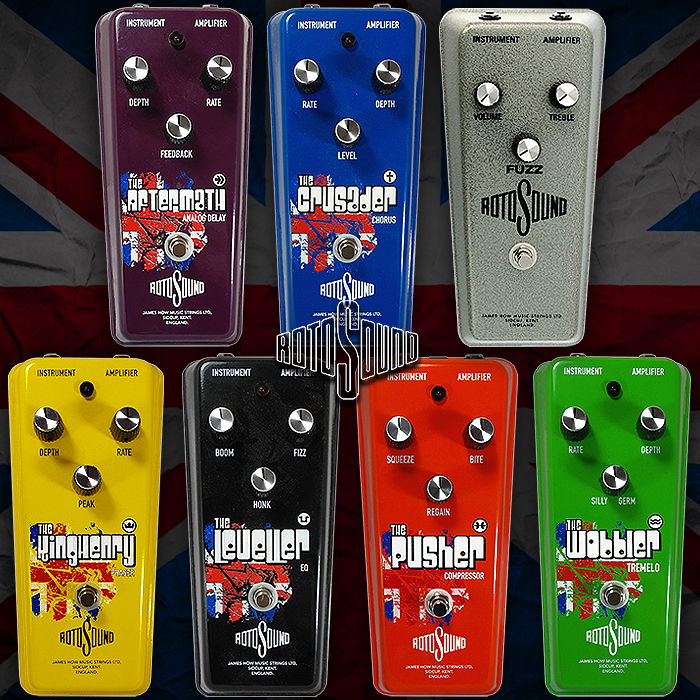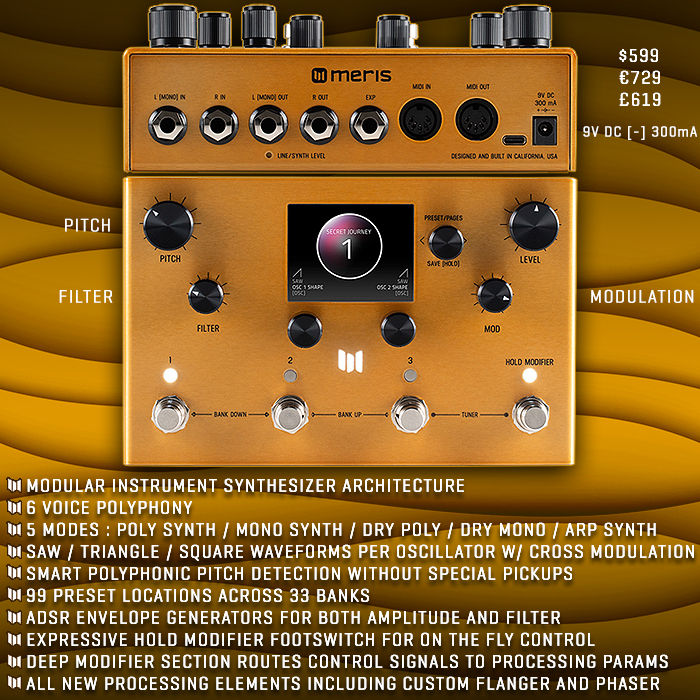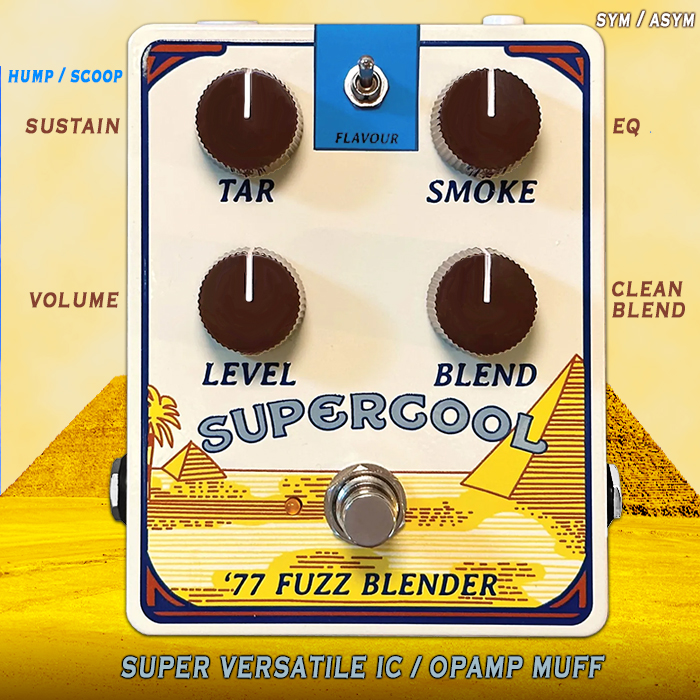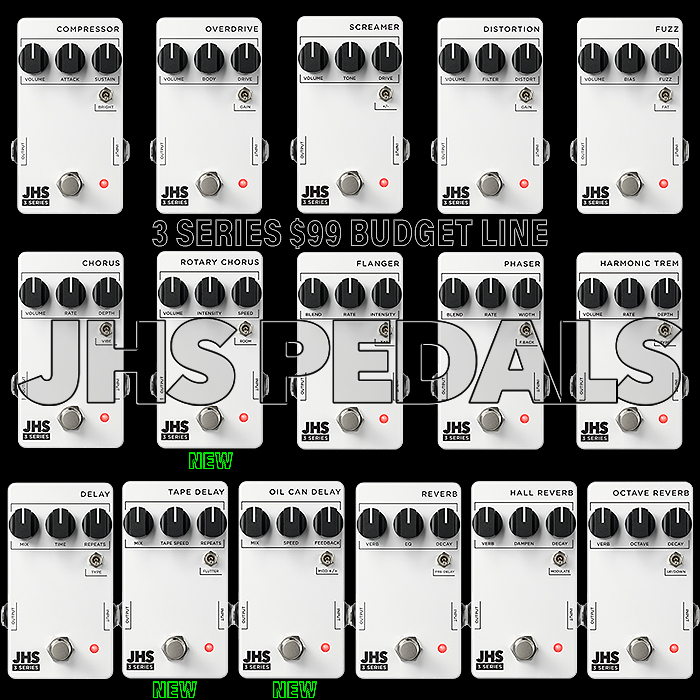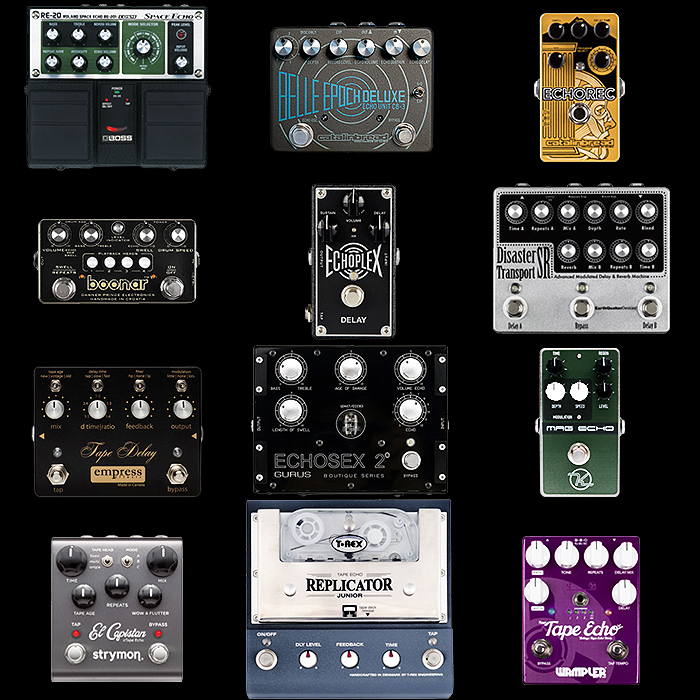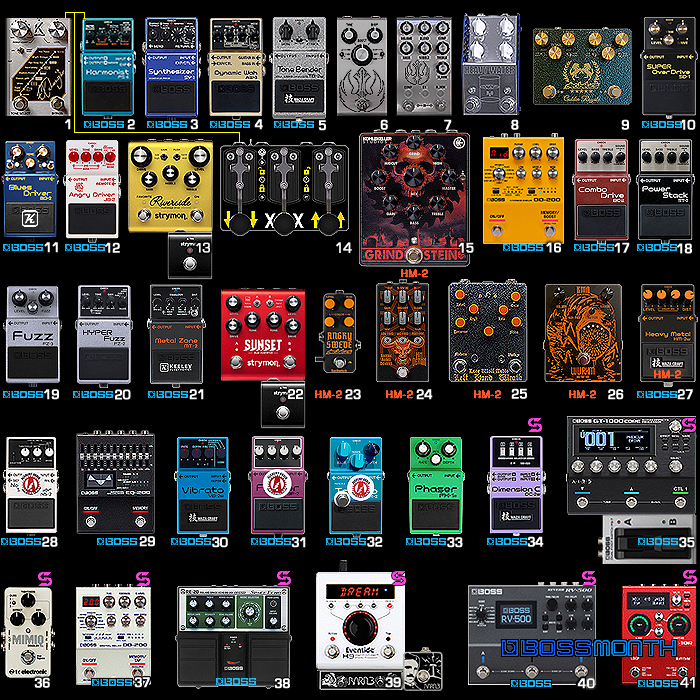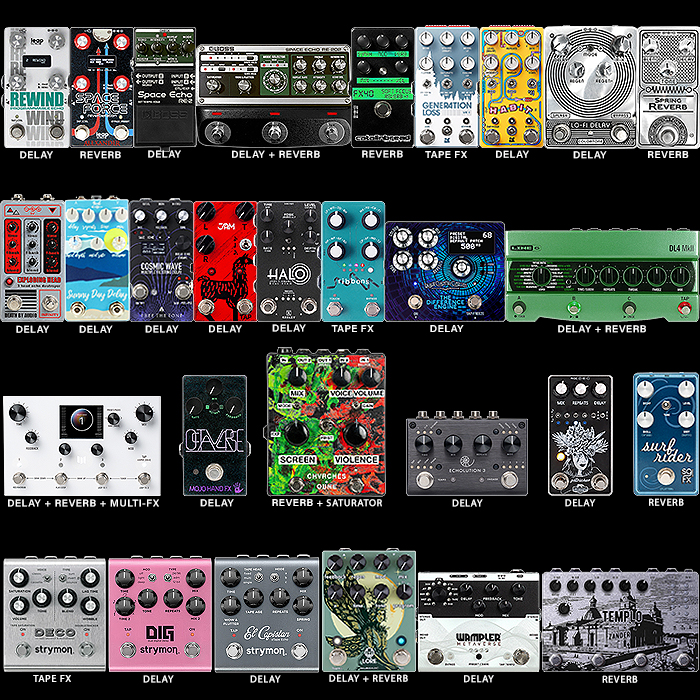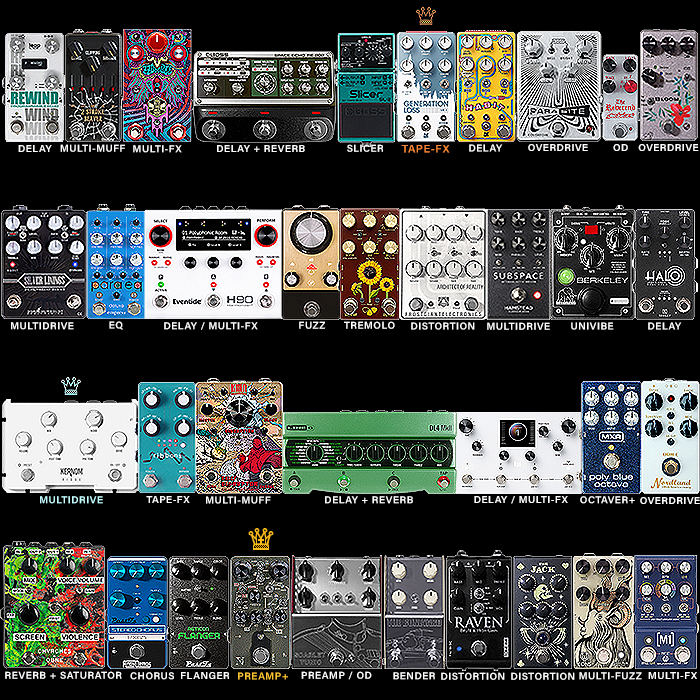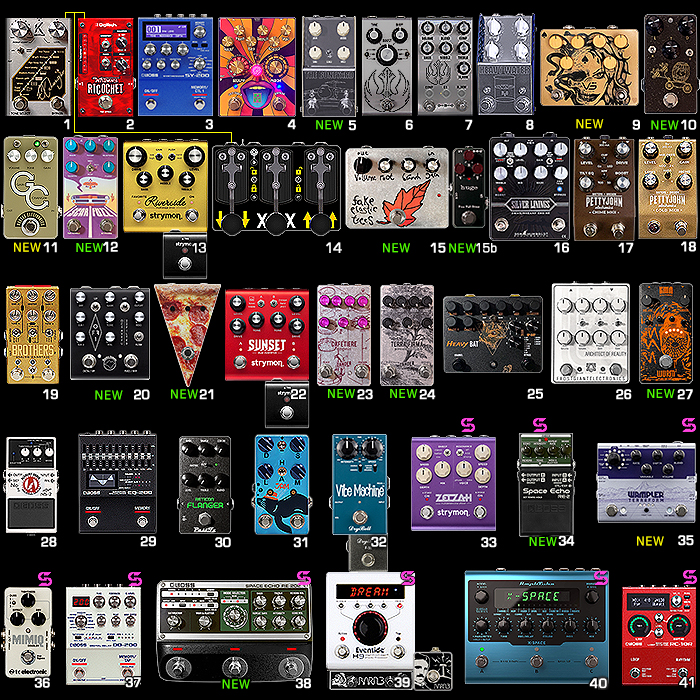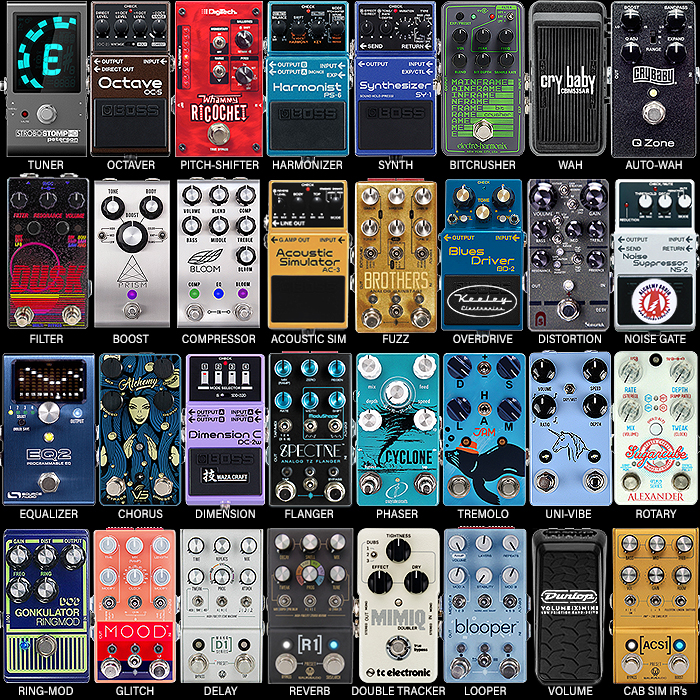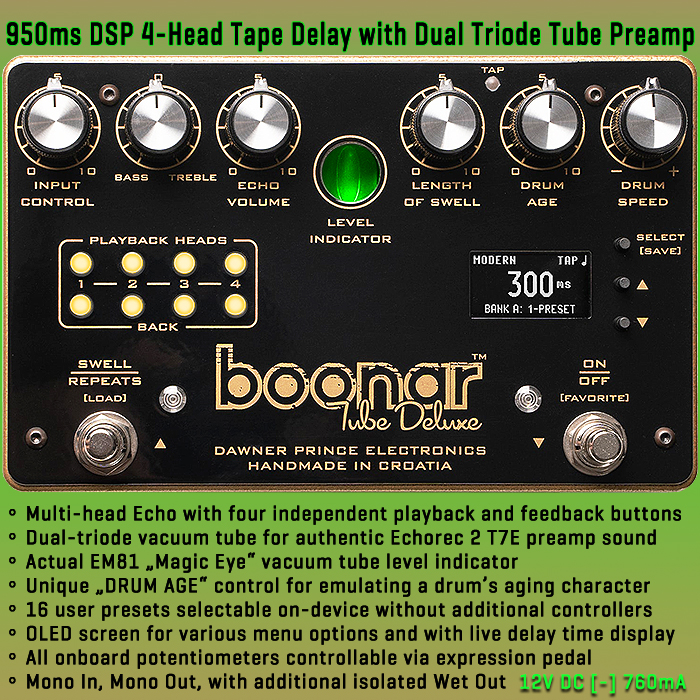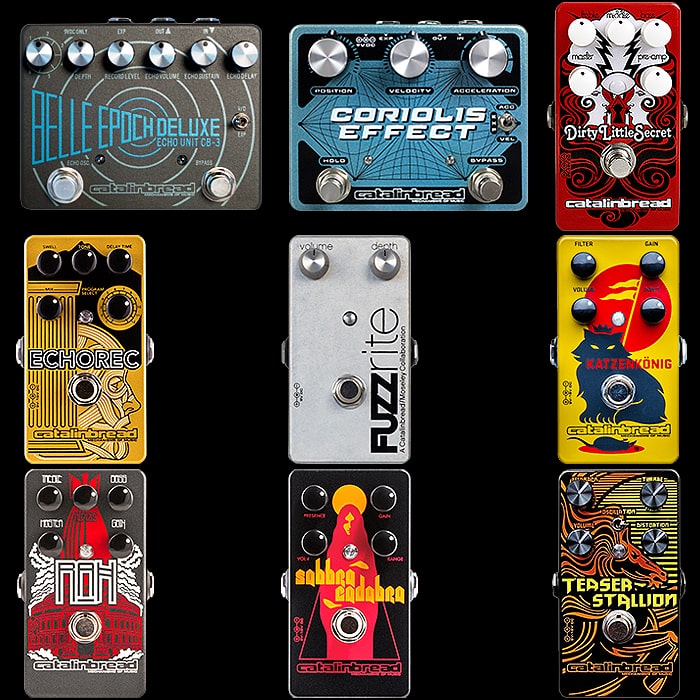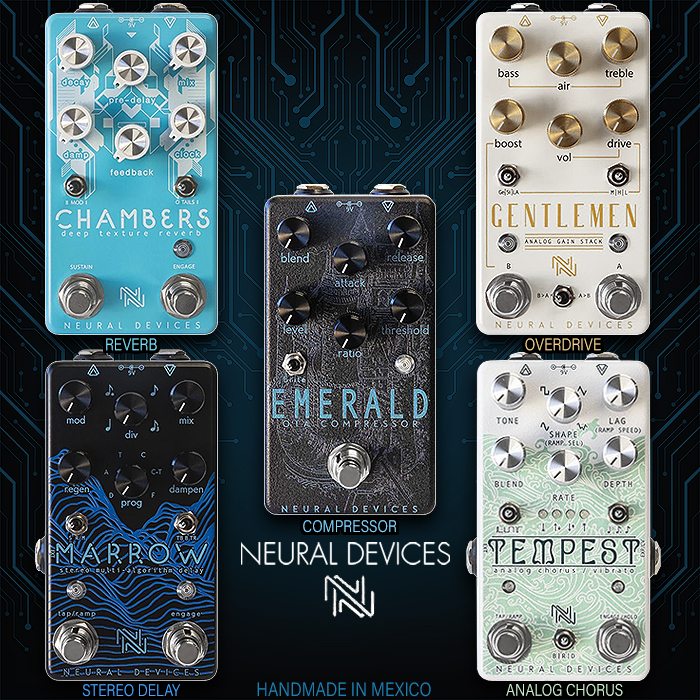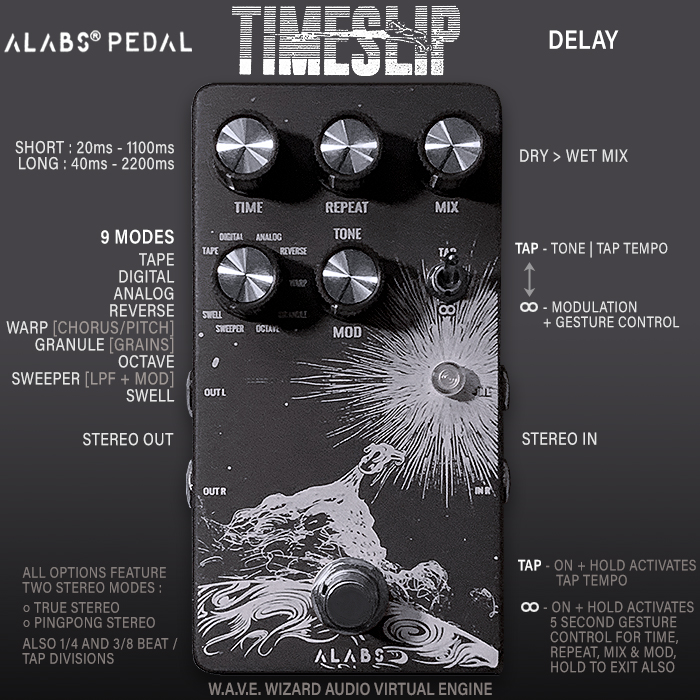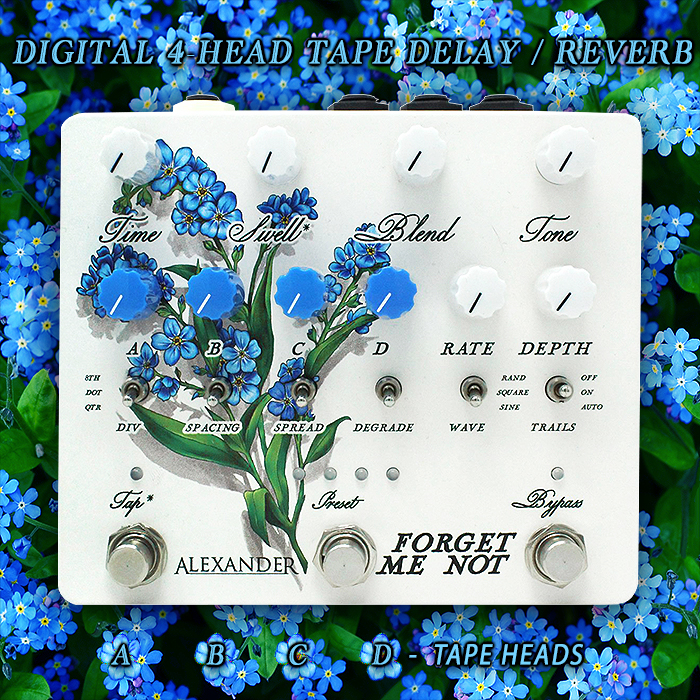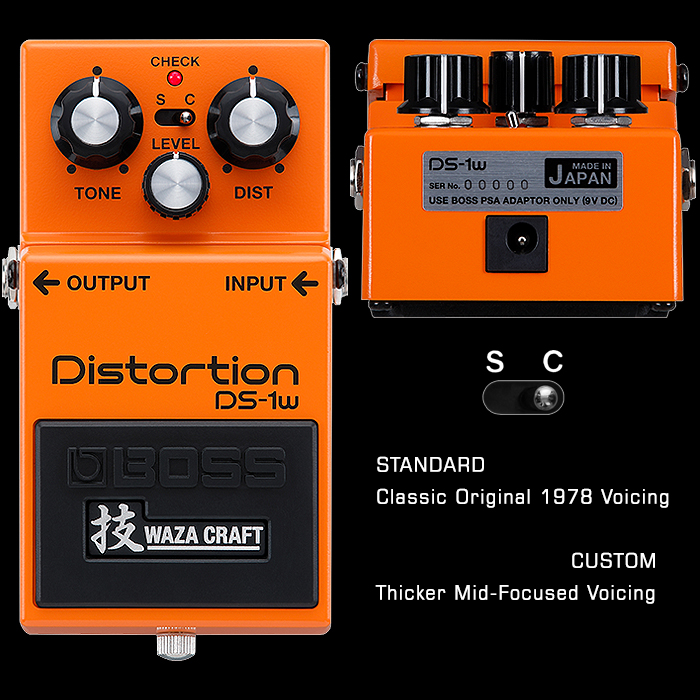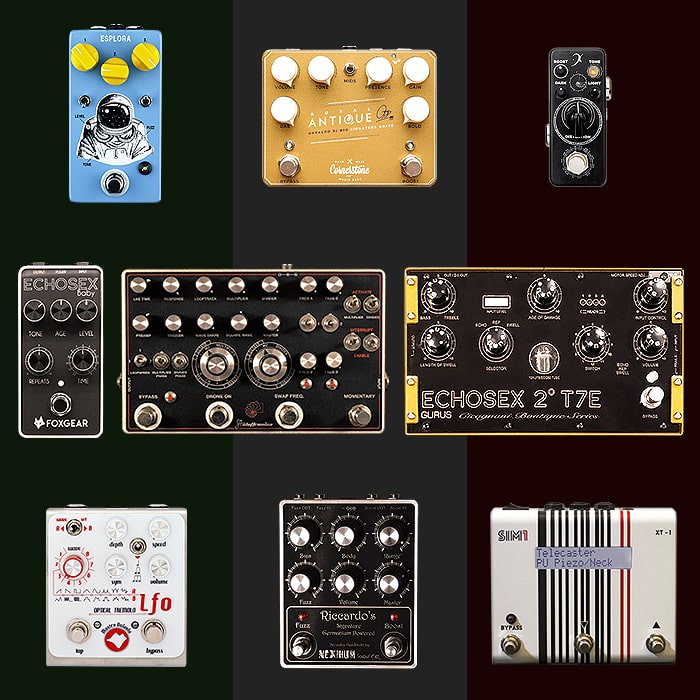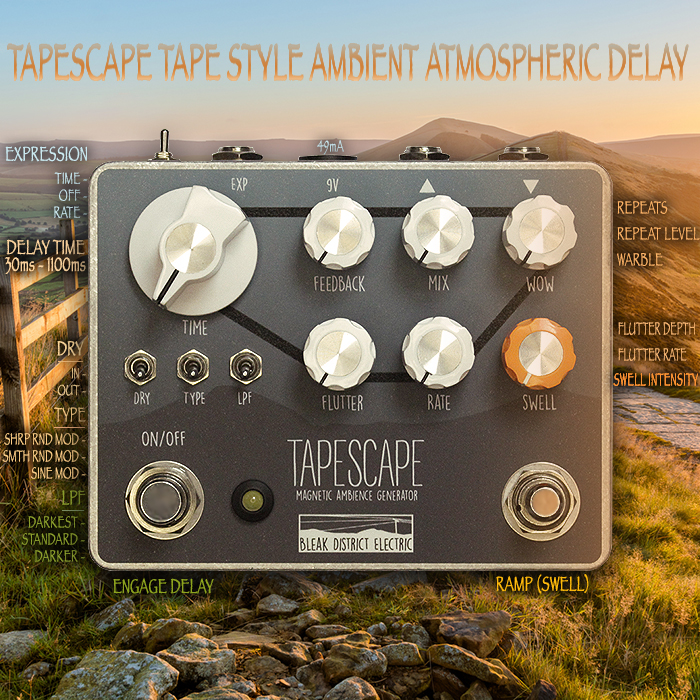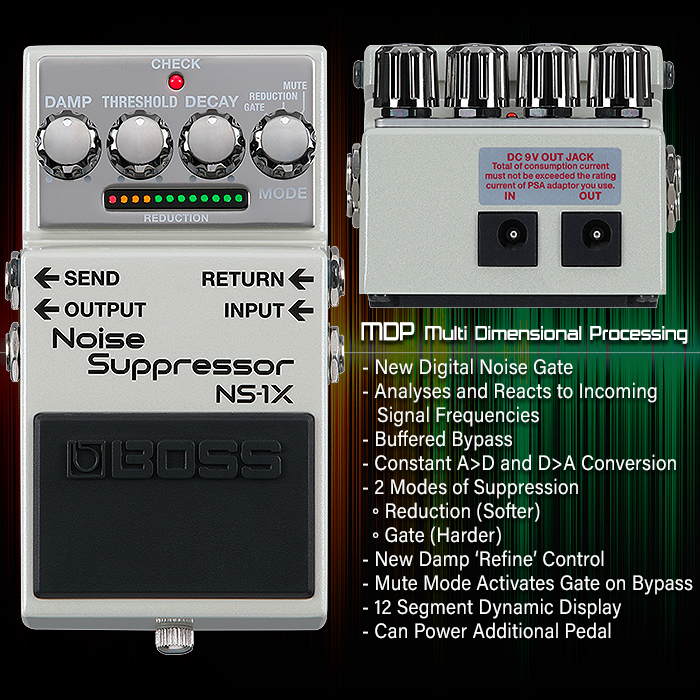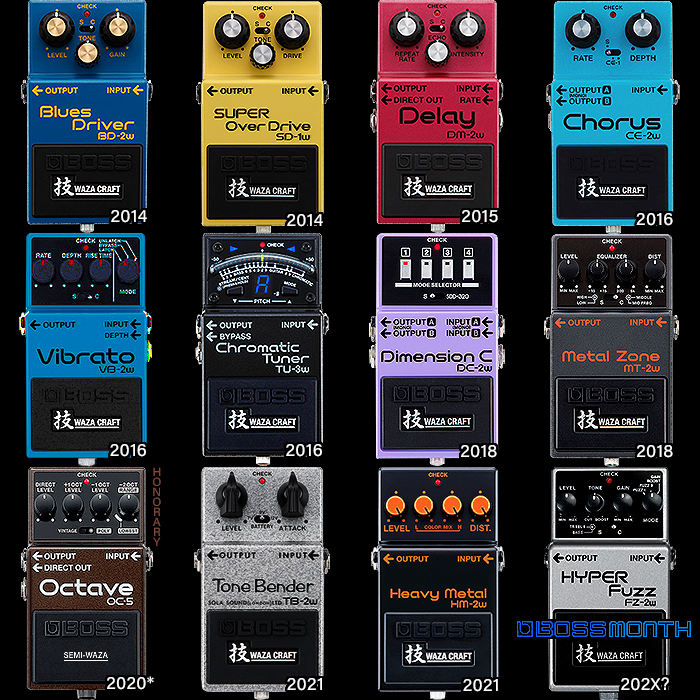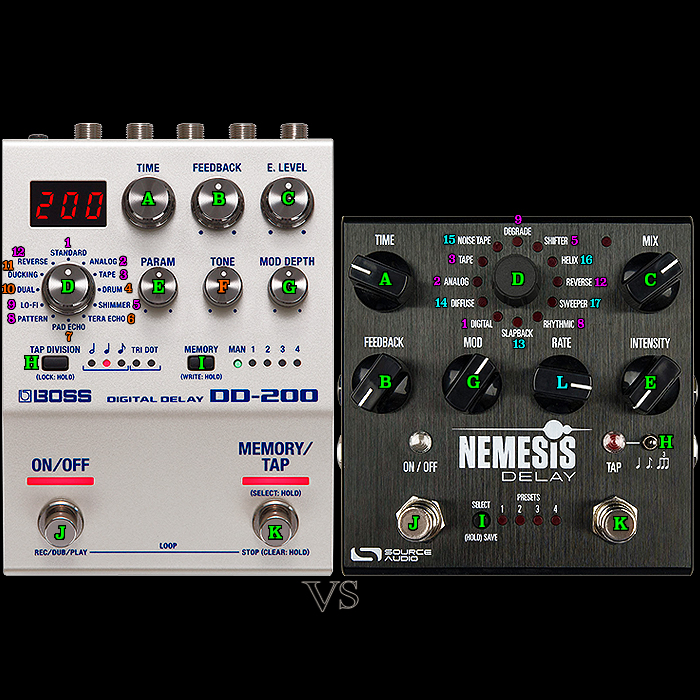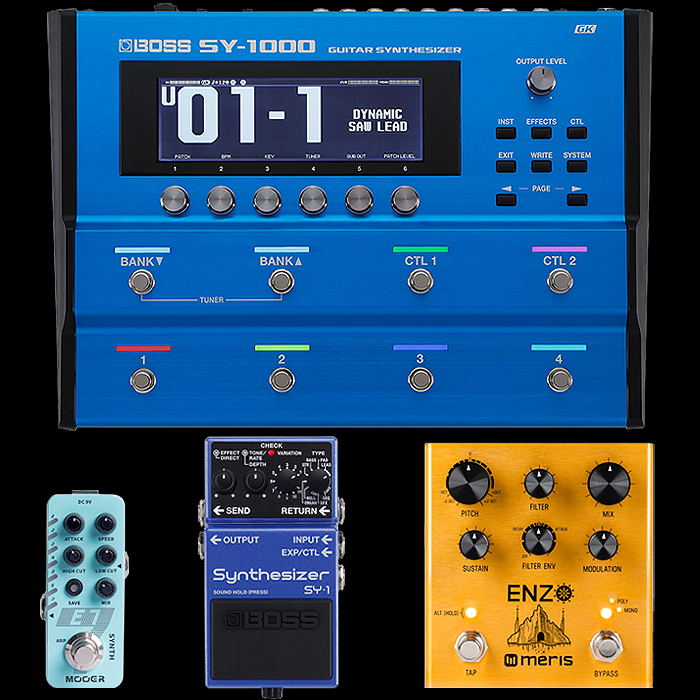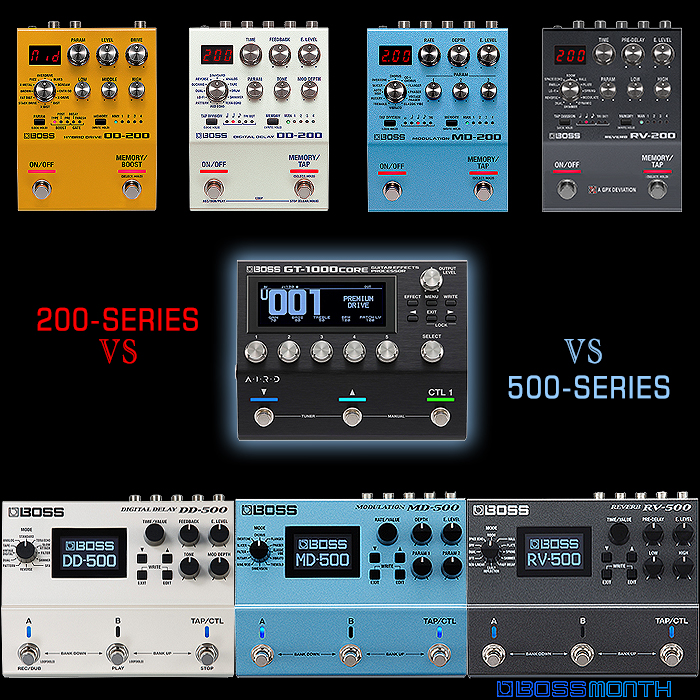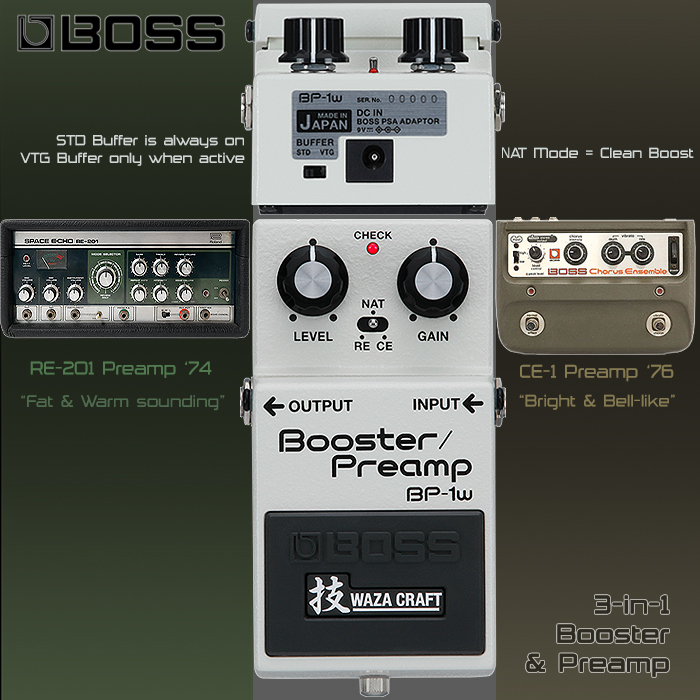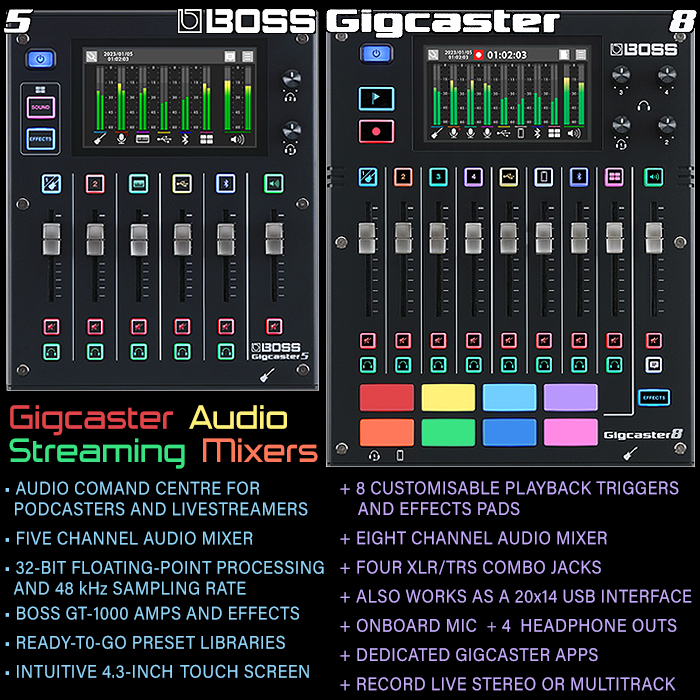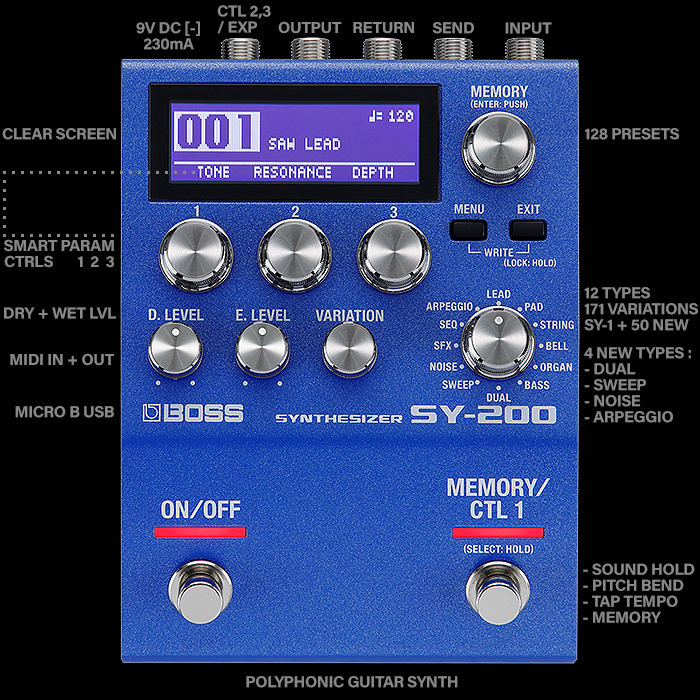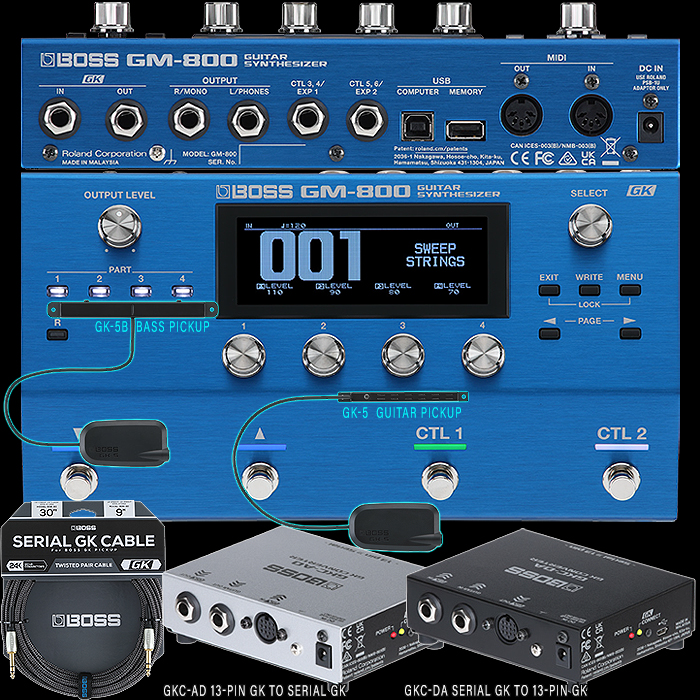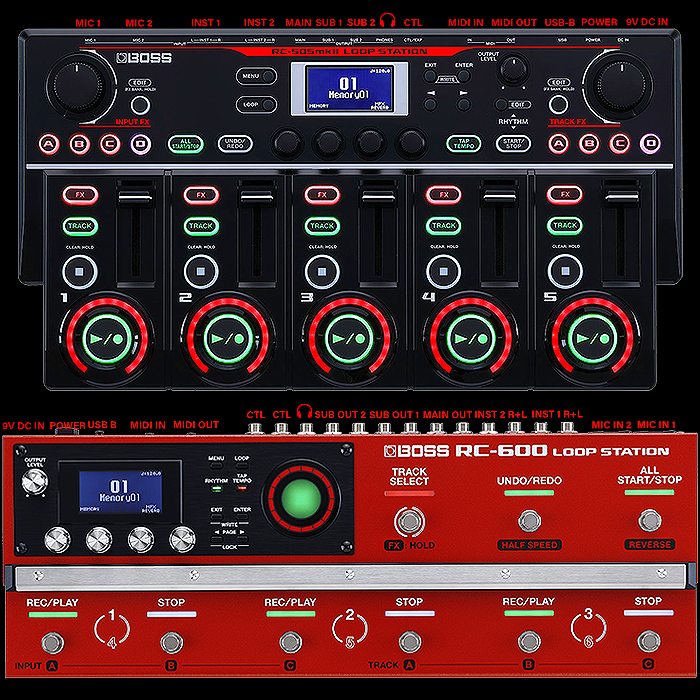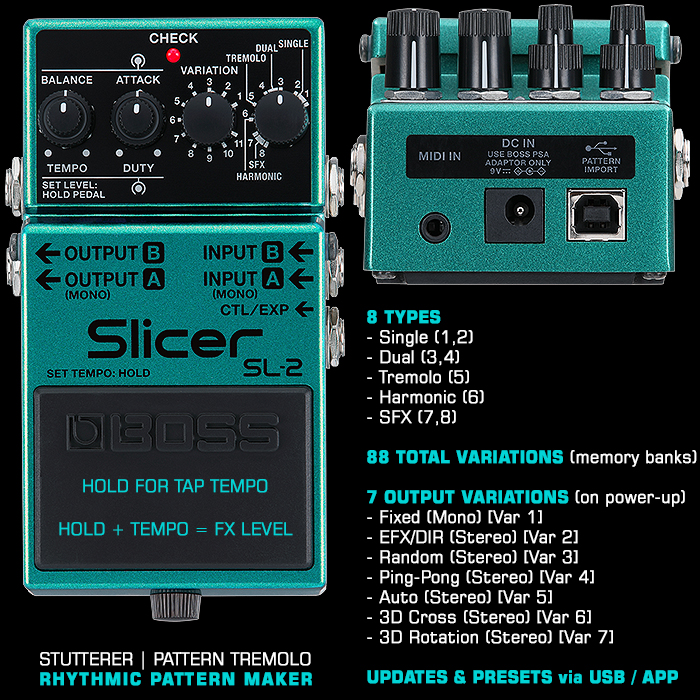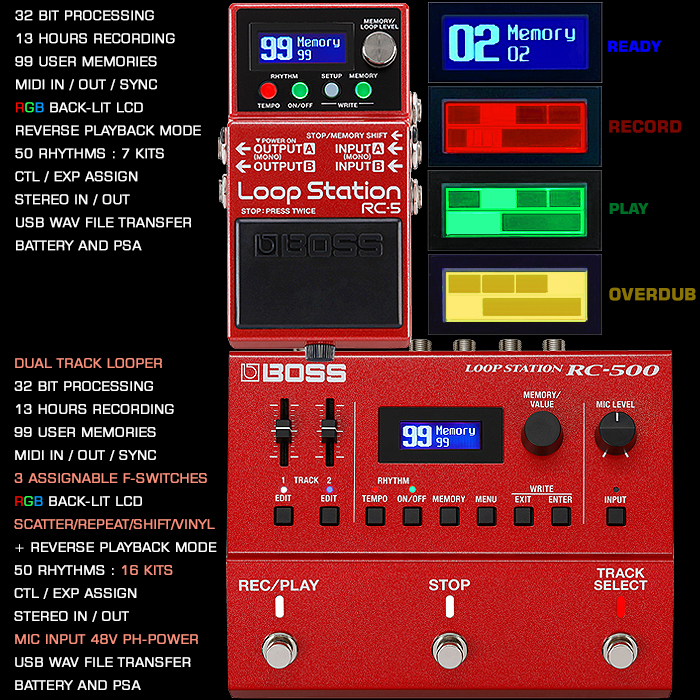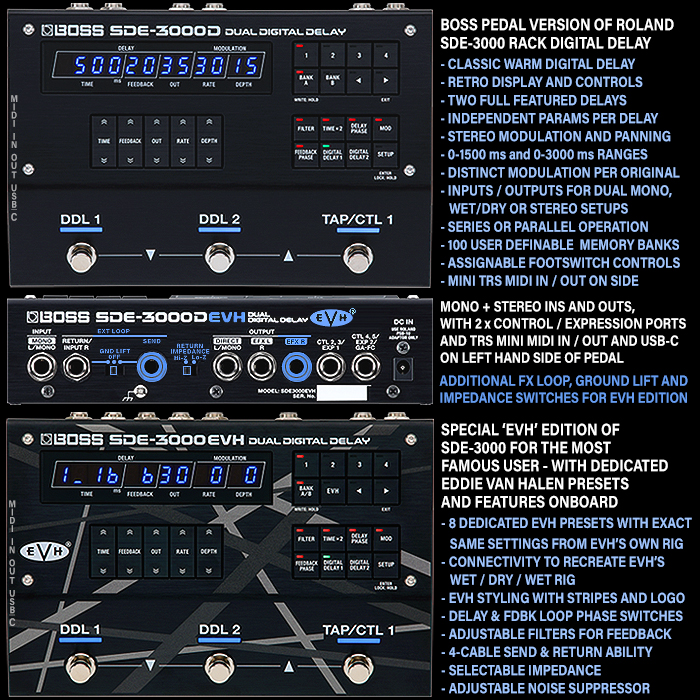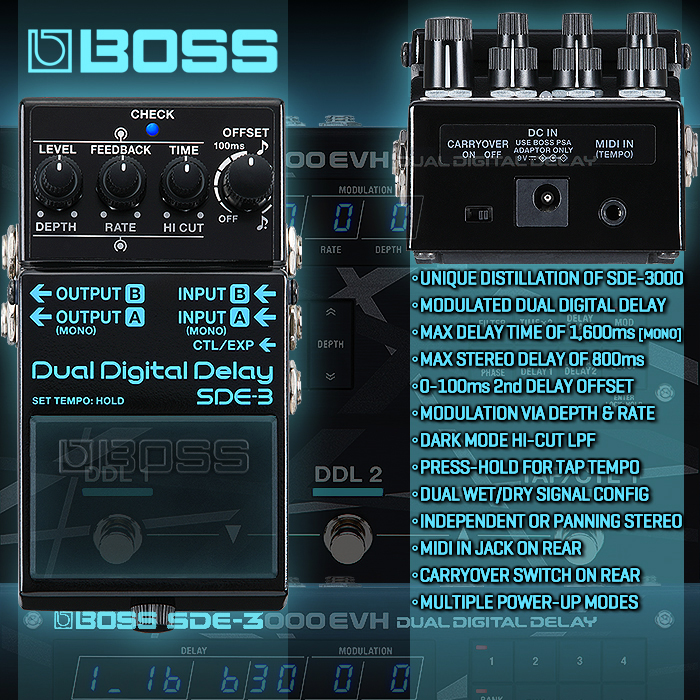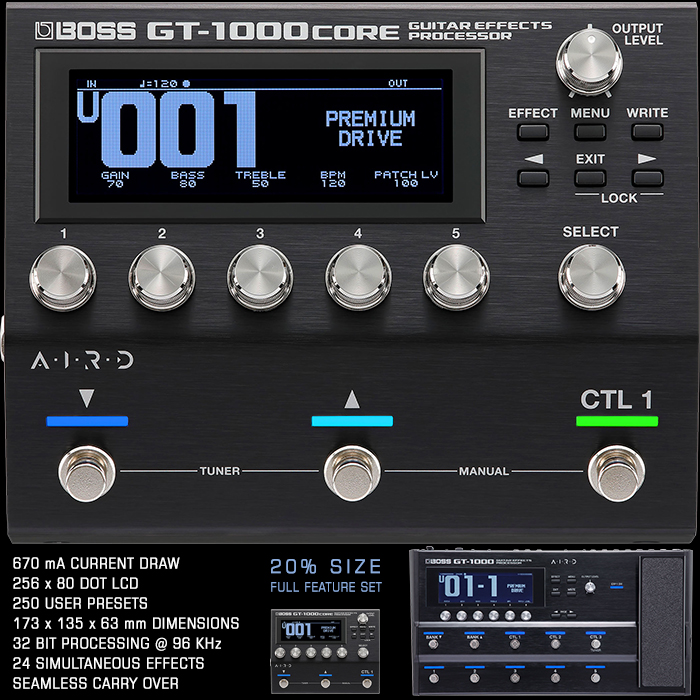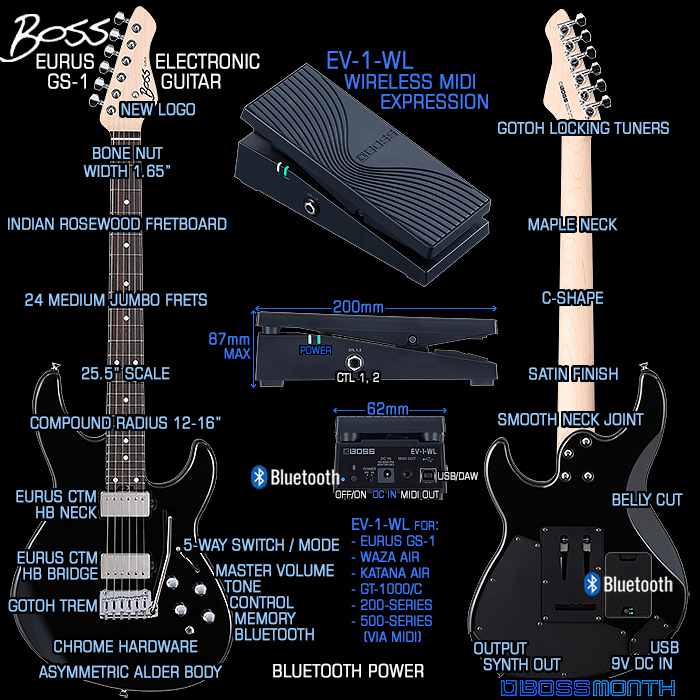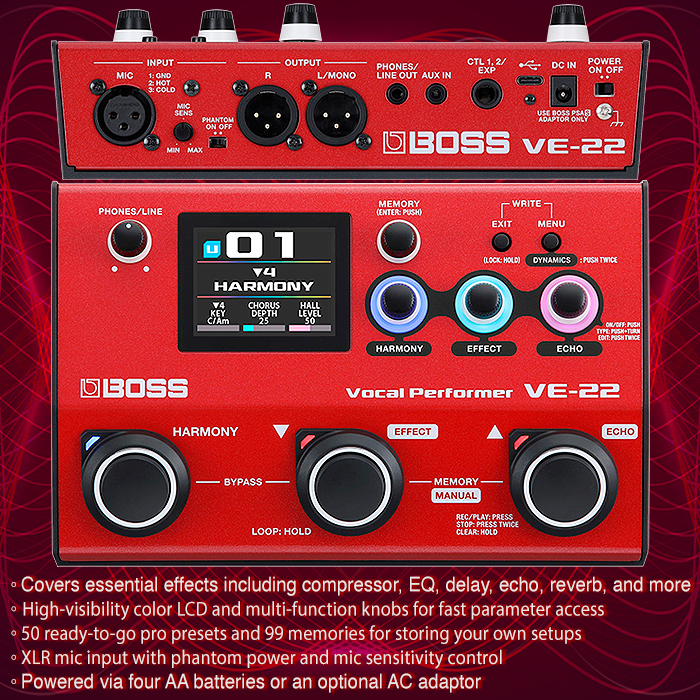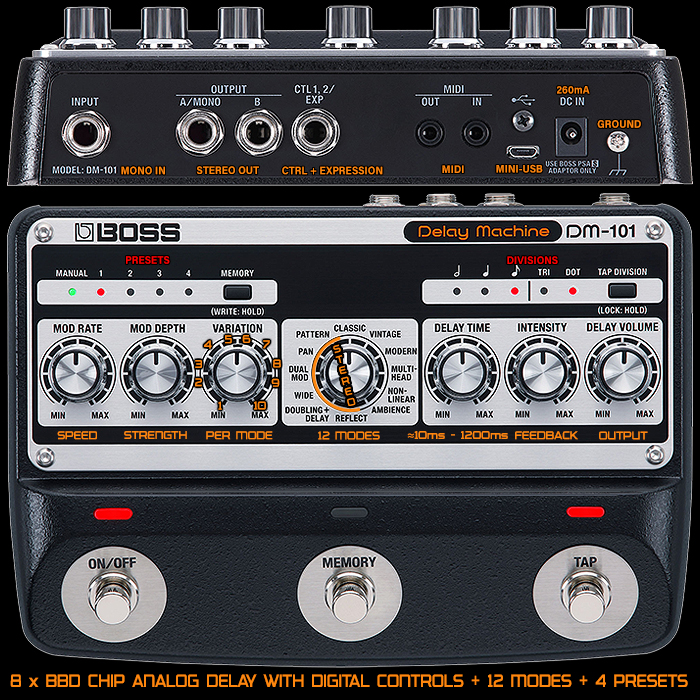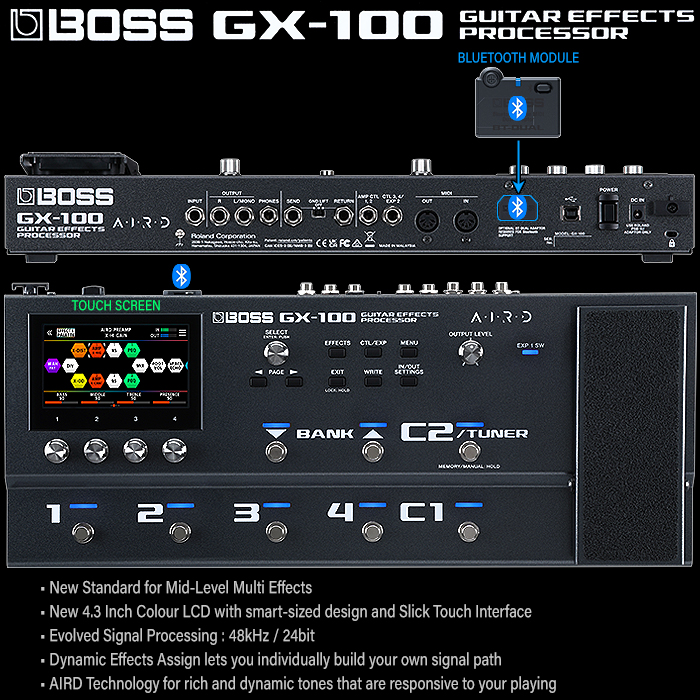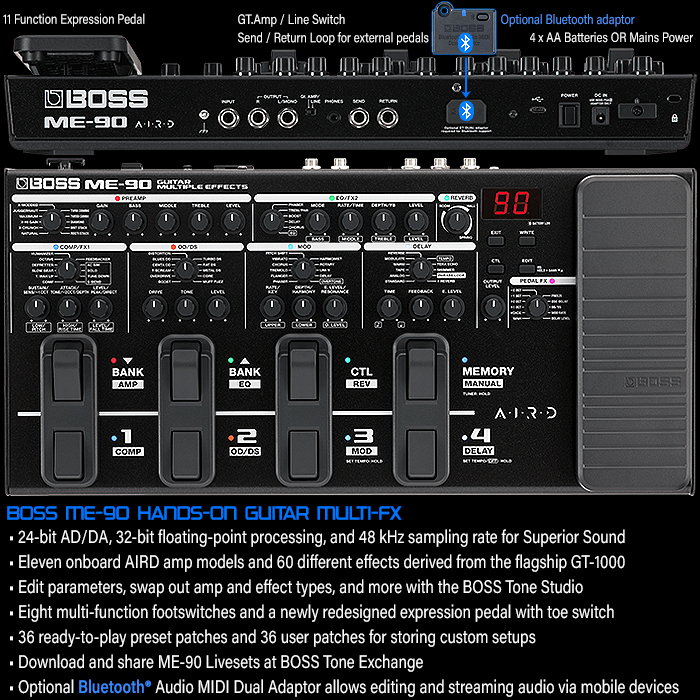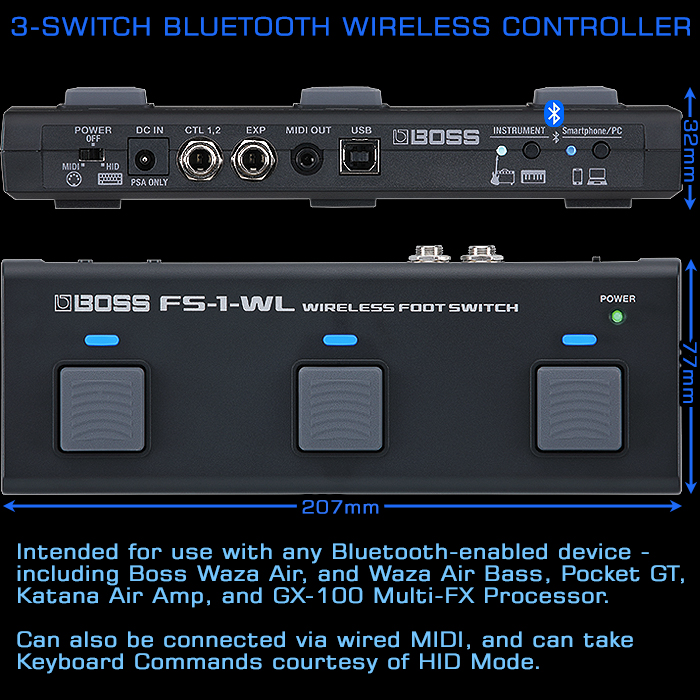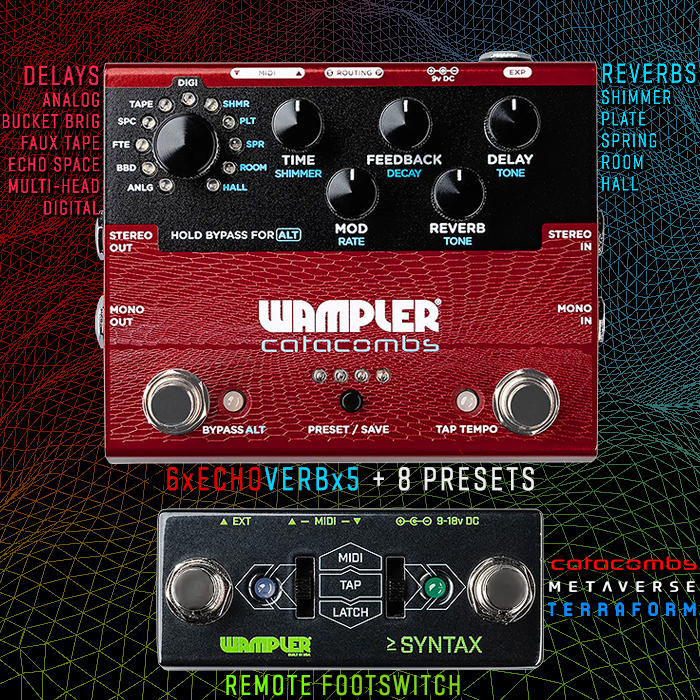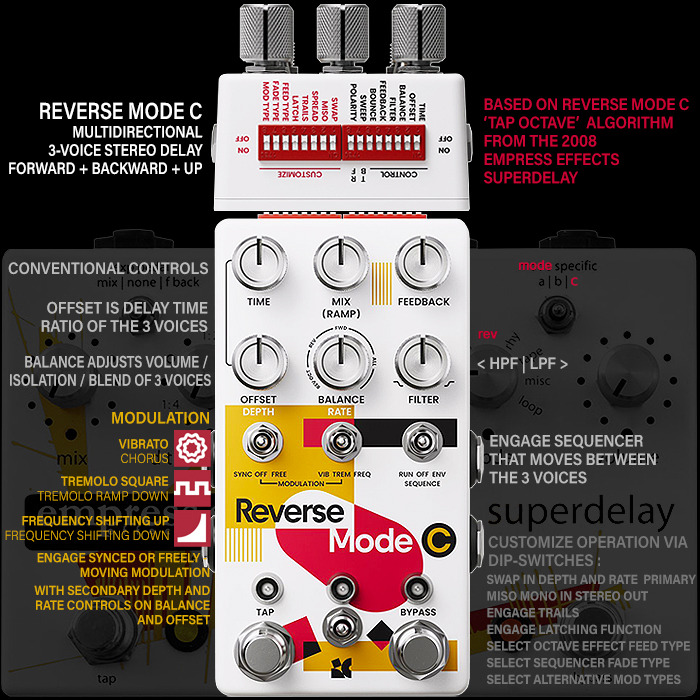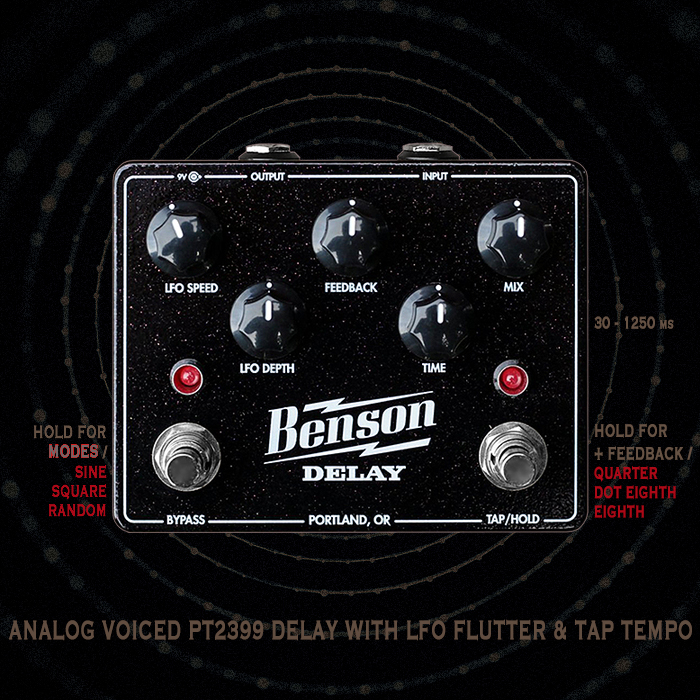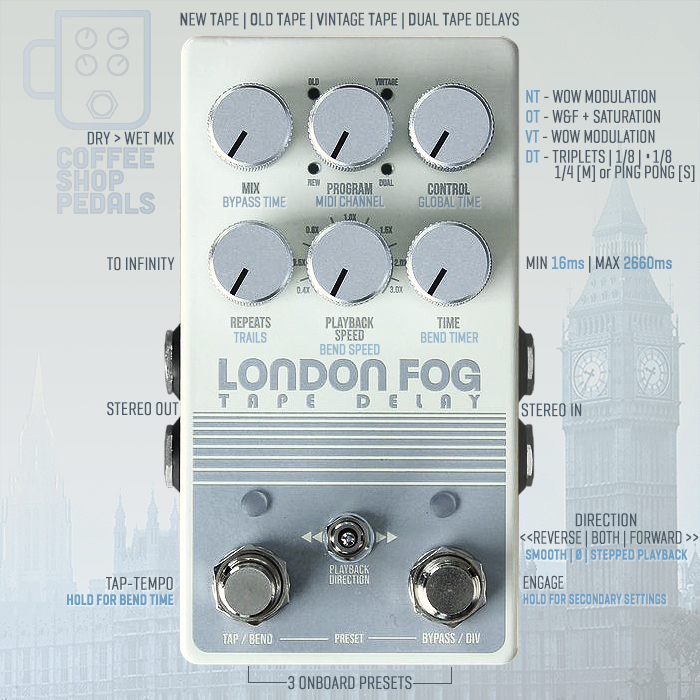Boss Re-Tools its Space Echo - with two brand new Improved Stereo Compact and Large Higher Fidelity Units - the RE-2 and RE-202

Readers should know by now that my favourite style of Delay is Tape-Style, where for me the king of that format is the Roland / Boss Space Echo and variants thereof. My favourite candidate of old has been the Strymon Volante - as you’ve seen regularly from my monthly Pedal-Chain Updates - while I’ve also dabbled a little with the Boss RE-20 Space Echo.
Boss is now retiring that well-loved pedal (RE-20) and introducing two new models - the RE-2 and RE-202 with higher fidelity components and featuring the latest Boss technological advances and DSP. The RE-2 Compact is largely a replacement for the RE-20 - it has largely the same 3-Head Playback + Reverb Mode options (11 Modes) - while making do without the RE-20’s Input Volume / Saturation control. While we also have the new Wow & Flutter control here. You press and hold the main footswitch for Tap Tempo or you can hold for the Twist (Oscillation) effect - depending on how you set up the pedal. To all intents and purposes the RE-2 model is considered the near enough like-for-like replacement for the RE-20 - at a much more compact size.
In contrast, the RE-202 is a significantly extended range variety with more options, Onboard Presets, 5 different Reverb voicings, and 4-Head Playback for the first time across 12 Modes. The RE-202 introduced Tape Condition (New / Aged), and Wow & Flutter - while the Reverb is fully independent and can be deactivated and reactivated dynamically while holding down the middle footswitch - which otherwise scrolls through presets. Having the 4 central LEDs indicate the arrangement of playback heads is super helpful too! The sharp-eyed among you will note that the RE-202 is a modern homage to the very original Boss pedal enclosure design - of the CE-1 Chorus Ensemble.
The new RE-202 has for sure become my favourite Space Echo of all - it is juicier than the Volante, and significantly more pristine than the RE-20. It has a broader range of flavours than both and is incredibly intuitive and easy to deploy.
I have had both the RE-2 and RE-202 in the chain for a good couple of months now and have tested both intensively over that period. Incredibly they both have the exact same 48Hz sampling, 32-bit floating point core tone generation engine - the main differences are in the number of Playback Heads, Modes, Control Topology, use of indicator LEDS, and Presets. Generally the larger device is easier to control - and has slightly more granularity than its more compact sibling - while there is a huge amount of overlap and they can both sound just as good as each other.
On the larger RE-202 you get 4 onboard Presets plus the manual panel settings - which are really easy to switch between via the 2nd / middle footswitch - holding that down deactivates and reactivates the Reverb too. So the RE-202 is both more granular and easier to deploy overall - while the Compact is perfect for your fly-board - or when space is a little tighter. At 192mm wide the RE-202 certainly falls within the large pedal enclosure category - where for instance the Volante is 177mm, the RE-20 is 173mm, and the RE-2 is just 73mm wide.
Both the new Boss Space Echoes are killer for their own applications - and both sound amazing. For me the larger one is more useful on a day-to-day basis and as Tape-Delay is my main flavour, and this my main delay pedal - then it’s perfect for my needs as an easy replacement for the Volante. If you typically deploy several delays, and tape-style is just one of several flavours you deploy - then the RE-2 of course is the more suitable option.
I don’t think anyone is going to be disappointed with either of these two pedals - while my favourite for sure is the larger one - it’s not quite as granular as the Volante in some ways (in terms of playback patterns), but it delivers a lot more flavour and is easier to use overall. I’ve never liked how the presets worked on the Volante - and while I love the individual Tape-head / Feedback buttons and Spacing Dial - the RE-202 is overall easier for me to operate. I will still be rotating the Volante in every now and again - as that does some distinct things that other pedals of that type don’t do. While I prefer in the main the tones and experience delivered by the RE-202. If you prefer subtler variations of tape-delay then the Volante may still be a preferable choice for you. While the Boss seems to have a touch more soul about it!
Here follow the individual details per unit - first the Compact RE-2 then the Larger RE-202 :
RE-2 Space Echo Stereo Tape-Style-Delay + Reverb - €249 | $249 | £189
Controls - MODE knob (11), REPEAT RATE knob, WOW & FLUTTER knob, INTENSITY knob, TONE knob, ECHO knob, REVERB knob, CARRYOVER switch (on rear), Main Pedal switch
As mentioned int the intro - the RE-2 is actually intended as the replacements for the RE-20 and has largely the same topology but in miniature. It has singular Tone control in place of separate Bass and Treble controls, it also makes do without the Input Volume / Saturation control, but has the new Wow & Flutter control added over and above the RE-20.
Most everything else is retained from the larger dual-pedal edition, where the single footswitch is now both the engage / bypass, and the Tap Tempo (Hold), You can setup the RE-2 to apply the Twist effect (Oscillation) on Hold versus Tap Tempo. Otherwise we have full stereo ins and outs, a CTL / EXP port, and a CARRYOVER switch (trails) on the rear of the pedal.
Both the RE-2 and RE-20 are based on the original Roland RE-201 - which had only 3 playback heads. So instead of choosing arrangements of 4 Heads like on the RE-202, we have 3 Heads + Reverb!
RE-2s 11 MODES
3 Playback Heads + Reverb
R = Reverb, x = No Reverb
- 01 : ▷ | - | - | x
- 02 : - | ▷ | - | x
- 03 : - | - | ▷ | x
- 04 : - | ▷ | ▷ |x
- 05 : ▷ | - | - | R
- 06 : - | ▷ | - | R
- 07 : - | - | ▷ | R
- 08 : ▷ | ▷ | - | R
- 09 : - | ▷ | ▷ | R
- 10 : ▷ | - | ▷ | R
- 11 : ▷ | ▷ | ▷ | R
RE-2 Key Features and Specs
- Sampling Frequency : 48 kHz
- AD Conversion : 24 bits + AF method - * AF method (Adaptive Focus method) This is a proprietary method from Roland & BOSS that vastly improves the signal-to-noise (SN) ratio of the AD converter.
- DA Conversion : 32 bits
- Processing : 32-bit floating point
Modes : 11 Modes - Nominal Input Level : INPUT A(MONO), INPUT B: -20 dBu
- Maximum Input Level : INPUT A(MONO), INPUT B: +7 dBu
- Input Impedance : INPUT A(MONO), INPUT B: 1 M ohm
- Nominal Output Level : OUTPUT A(MONO), OUTPUT B: -20 dBu
- Maximum Output Level : OUTPUT A(MONO), OUTPUT B: +7 dBu
- Output Impedance : OUTPUT A(MONO), OUTPUT B: 1 k ohm
- Recommended Load Impedance : OUTPUT A(MONO), OUTPUT B: 10 k ohms or greater
- Bypass : Buffered bypass
- Controls : MODE knob, REPEAT RATE knob, WOW & FLUTTER knob, INTENSITY knob, TONE knob, ECHO knob, REVERB knob, CARRYOVER switch, Pedal switch Indicator : CHECK indicator (Used for indication of check battery)
- Connectors : INPUT A(MONO) jack, INTPUT B jack, OUTPUT A(MONO) jack, OUTPUT B jack: 1/4- inch phone type, CTL/EXP jack 1/4-inch TRS phone type, DC IN jack
- Power Supply : Alkaline battery (9 V, 6LR61) / AC adaptor (PSA series: sold separately)
- Current Draw : 75 mA
- Expected battery life : under continuous use (These figures will vary depending on the actual conditions of use.) - Alkaline : Approx. 4.5 hours
- Dimensions : 73 (W) x 129 (D) x 59 (H) mm / 2-7/8 (W) x 5-1/8 (D) x 2-3/8 (H) inches
- Weight (including battery) : 450 g / 1 lb
- Accessories : Leaflet ("USING THE UNIT SAFELY," "IMPORTANT NOTES," and "Information") Dry battery (9 V, 6LR61)
- Options (sold separately) : AC adaptor : PSA series, Footswitch : FS-5U, Dual footswitch : FS-6, FS-7, Expression pedal : FV-500H, FV-500L, EV-30, Roland EV-5
- RRP : €249 | $249 | £189
RE-202 Space Echo Stereo Tape-Style-Delay + Reverb - €399 | $399 | £305
Controls : ON/OFF switch (Hold for Warp effects), MEMORY switch (Hold for Reverb Deactivate / Reactivate), TAP switch (Hold for Twist effect), SATURATION knob, WOW & FLUTTER knob, MODE SELECTOR knob, BASS knob, TREBLE knob, REVERB VOL knob, REPEAT RATE knob, INTENSITY knob, ECHO VOL knob MEMORY
The RE-202 has in part been designed to take on more recent Tape-Delay style pedals - with a particular focus on the Strymon Volante. That has 3 different Voicings : Drum / Tape / Studio. where the RE-202 has purely the classic Roland Space Echo voicing - which correlates with the Volante's 'Tape'. The Volante has slightly more granularity in that you can select Playback Heads in any Combination - with added optional Feedback on each. The Volante also has a smart Spacing dial - which changes the swing essentially of those patterns.
The RE-202 has Bass and Treble vs the single Hight Cut of the Volante
The Volante has Mechanics and Wear controls - while the RE-202 has Wow & Flutter and Tape Condition : New / Aged.
Both have Onboard Presets - while the Volante's ones are really clunky to apply and change.
I would say that overall the Volante has more granularity in tape-head arrangement - with the additional spacing control - and it has 3 different voicings vs the RE-202's one. It also has Sound-on-Sound style looping which is pretty handy - while I've never used that much.
The RE-202 counters that with much more flavour onboard - it gets much fatter and juicier than the Volante does - which has often been a criticism of that pedal - while it's magnificent for the more subtle flavours. The RE-202 also has 5 flavours of Reverb, that incredible preamp, and the Warp effect (Reverb burst / max decay) - while both pedals do the max feedback oscillation thing.
Generally the RE-202 sounds more flavoursome to me, and is overall easier to deploy - especially how easy it is to switch the Reverb off and on again, and scrolling through Presets.
RE-202's 12 MODES
4 Playback Heads :
- 01 : ▷ | - | - | -
- 02 : - | ▷ | - | -
- 03 : - | - | ▷ | -
- 04 : ▷ | ▷ | - | -
- 05 : - | ▷ | ▷ | -
- 06 : ▷ | - | ▷ | -
- 07 : ▷ | ▷ | ▷ | -
- 08 : ▷ | - | - | ▷
- 09 : - | - | ▷ | ▷
- 10 : ▷ | - | ▷ | ▷
- 11 : ▷ | ▷ | - | ▷
- 12 : ▷ | ▷ | ▷ | ▷
INDEPENDENT REVERB
Setting Reverb Type
I tend to mostly just use the stock Spring Reverb, while occasionally deploying Plate too. This is one of the many power-up settings - where you hold down footswitches on power-up to change some of the global settings. Note that you cannot currently select a different Reverb per preset - while that functionality will likely come with a future update.
Press and Hold the Tap footswitch on device power-up, then Turn Mode Selector to '12'.
Next press the 'Memory' button to scroll through those slots - each which corresponds to a different flavour of Reverb as follows :
- Manual = Default Spring Reverb
- #1 = Hall
- #2 = Plate
- #3 = Room
- #4 = Ambience
RE-202 Key Features and Specs
- Sampling Frequency : 48 kHz
- AD Conversion : 24 bits + AF method - * AF method (Adaptive Focus method) This is a proprietary method from Roland & BOSS that vastly improves the signal-to-noise (SN) ratio of the AD converter.
- DA Conversion : 32 bits
- Processing : 32-bit floating point
- Modes : 12 modes
- Memory : 127 + Manual
- Nominal Input Level : INPUT A/MONO, INPUT B: -10 dBu
- Maximum Input Level INPUT A/MONO, INPUT B: +7 dBu
- Input Impedance : INPUT A/MONO, INPUT B: 1 M ohm
- Nominal Output Level : OUTPUT A/MONO, OUTPUT B: -10 dBu
- Maximum Output Level : OUTPUT A/MONO, OUTPUT B: +7 dBu
- Output Impedance : OUTPUT A/MONO, OUTPUT B: 1 k ohm
- Recommended Load Impedance : OUTPUT A/MONO, OUTPUT B: 10 k ohms or greater
- Bypass : Buffered bypass
- Controls : ON/OFF switch, MEMORY switch, TAP switch, SATURATION knob, WOW & FLUTTER knob, MODE SELECTOR knob, BASS knob, TREBLE knob, REVERB VOL knob, REPEAT RATE knob, INTENSITY knob, ECHO VOL knob MEMORY button, INPUT button, TAPE button
- Connectors : INPUT A/MONO jack, INTPUT B jack, OUTPUT A/MONO jack, OUTPUT B jack: 1/4-inch phone type
CTL 1, 2/EXP jack: 1/4-inch TRS phone type, MIDI (IN, OUT) jacks: Stereo miniature phone type, DC IN jack
USB port : USB micro B-type (program update only) - Power Supply : AC adaptor
- Current Draw : 140 mA
- Dimensions : 192 (W) x 133 (D) x 52 (H) mm / 7-9/16 (W) x 5-15/64 (D) x 2-3/64 (H) inches | and : 192 (W) x 133 (D) x 53 (H) mm / 7-9/16 (W) x 5-15/64 (D) x 2-3/32 (H) inches (including rubber foot) Weight (including battery) : 860 g / 1 lb 15 oz
- Accessories : AC adaptor, Owner's Manual, Leaflet ("USING THE UNIT SAFELY," "IMPORTANT NOTES," and "Information"), Rubber foot
- Options (sold separately) : Footswitch : FS-5U, Dual footswitch : FS-6, FS-7, Expression pedal : FV-500H, FV-500L, EV-30, Roland EV-5, MIDI/TRS connecting cable: BMIDI-5-35, BMIDI-1-35, BMIDI-2-35, BCC-1-3535, BCC-2- 3535
- RRP : €399 | $399 | £305
RE-2 vs RE-202







